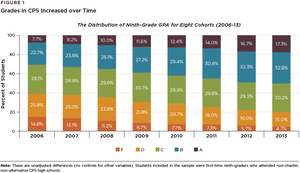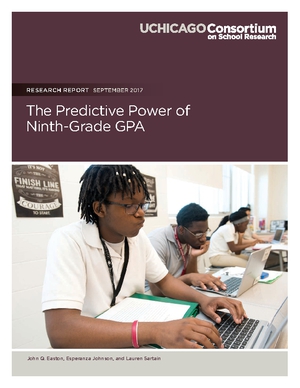1. What is the distribution of freshman GPA in Chicago Public Schools (CPS)? How has the distribution changed over time, specifically during a period where CPS had policies focused on freshman GPA? How do GPAs differ from one high school to another? How are GPAs related to student characteristics, including gender, race, economic background, prior test scores, and high school course-taking?
2. How well do freshman GPAs predict important student outcomes like high school graduation and college enrollment? In comparison to achievement test scores, are freshman GPAs good predictors of these outcomes?
3. To what extent do freshman GPAs measure student learning? In other words, are freshman GPAs related to student test score performance following the freshman year?
As parents and teachers know, and research has demonstrated, ninth grade is a critical year for students. It is when students’ high school habits and mindsets are formed and their ninth- through twelfth-grade trajectory begins to take shape. This study provides evidence that students' course performance in ninth grade is strongly related to grades later in high school, as well as the likelihood that they graduate from high school and pursue post-secondary education. The report shows that grades are a better predictor of future academic success than test scores. This suggests that students who have strong freshman grades are likely to do well academically in the future. These findings indicate that policymakers and practitioners can generally trust grades as a good indicator of skill and knowledge acquisition and academic success.
The report also shows trends and patterns in freshman grades. Ninth-grade GPA in CPS has been increasing over the last ten years, with far fewer students earning Fs. However, significant gaps remain by gender and race. For example, male students have lower GPAs than female students, and Black students have lower GPAs than students of other races. These gaps are consequential and point to opportunities for policy and practice to deliberately address them, similar to the recent focus on reducing "achievement gaps" in test scores.



